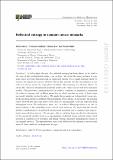Reflected entropy in random tensor networks
Author(s)
Akers, Chris; Faulkner, Thomas; Lin, Simon; Rath, Pratik
Download13130_2022_Article_18450.pdf (5.683Mb)
Publisher with Creative Commons License
Publisher with Creative Commons License
Creative Commons Attribution
Terms of use
Metadata
Show full item recordAbstract
Abstract
In holographic theories, the reflected entropy has been shown to be dual to the area of the entanglement wedge cross section. We study the same problem in random tensor networks demonstrating an equivalent duality. For a single random tensor we analyze the important non-perturbative effects that smooth out the discontinuity in the reflected entropy across the Page phase transition. By summing over all such effects, we obtain the reflected entanglement spectrum analytically, which agrees well with numerical studies. This motivates a prescription for the analytic continuation required in computing the reflected entropy and its Rényi generalization which resolves an order of limits issue previously identified in the literature. We apply this prescription to hyperbolic tensor networks and find answers consistent with holographic expectations. In particular, the random tensor network has the same non-trivial tripartite entanglement structure expected from holographic states. We furthermore show that the reflected Rényi spectrum is not flat, in sharp contrast to the usual Rényi spectrum of these networks. We argue that the various distinct contributions to the reflected entanglement spectrum can be organized into approximate superselection sectors. We interpret this as resulting from an effective description of the canonically purified state as a superposition of distinct tensor network states. Each network is constructed by doubling and gluing various candidate entanglement wedges of the original network. The superselection sectors are labelled by the different cross-sectional areas of these candidate entanglement wedges.
Date issued
2022-05-24Department
Massachusetts Institute of Technology. Center for Theoretical PhysicsPublisher
Springer Berlin Heidelberg
Citation
Journal of High Energy Physics. 2022 May 24;2022(5):162
Version: Final published version